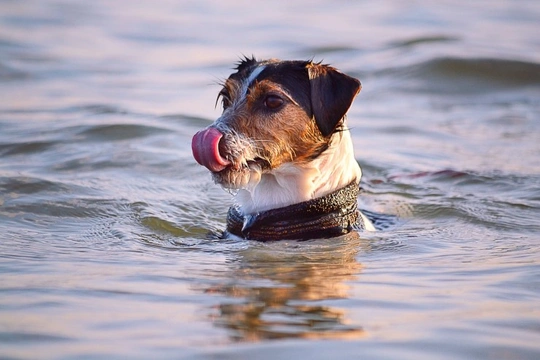
Getting your dog comfortable around water
Swimming, splashing about and playing in safe, clean water can be very rewarding for dogs, who often enjoy swimming because it is fun and different. Swimming can also be a great form of exercise for your dog too, providing a low impact, full body workout that can help to keep them supple and strong. While many dog breeds have a long history of swimming and being in and around water, such as the flat coated retriever and Labrador retriever, some dogs are more speculative about or will actively avoid it altogether! Some dogs cannot swim due to their conformation and build too, and so when it comes to swimming and dogs, it is not always as intuitive as you might think.
In this article, we will look at different tips and tricks that you may want to try to encourage a reluctant dog to swim and enjoy the water, and how to avoid putting them off for good! Read on to learn more.
Can your dog swim?
First of all as mentioned, not all dogs are physically capable of swimming, and so you should do everything that you can to find out if your dog is among them before you try to fling them in at the deep end! Check out this article about dogs that cannot or may not be able to swim to get all of the facts.
Introducing your dog to water
If your dog has never really seen water before, you are not sure if they want to swim or are not sure how they will react, your first step should be finding an appropriate water source that they can see and think about in their own time. Pick a calm water source without tides and that has sloping banks so that your dog can walk in and out of the water on their own terms, and see what they do when they get there. Also, make sure that you pick a time of year when the water will not be cold, and remember that even if the day is warm, the water will be much colder.
You may find that your dog is raring to go and leaps right in-but don’t be surprised if they don’t!
Start small
If your dog is not quite sure what to do when they get to the water or seems to be actively wary of it, how you handle things and the way you respond to your dog can make all the difference to whether they decide to go for a dip or not! You should be calm and encouraging about it but not overly excitable or pushy, and try to ensure that your dog does not get scared or discouraged early on.
Keep your first visit to the water short, and just let your dog think about it, and they will remember the day as a positive thing.
Make it fun
If your dog doesn’t know what to make of the water or doesn’t seem to know that swimming is an option, you can try to encourage them to dip a toe in by turning it into a game. Throw a toy that floats into the first couple of feet of the water, paddle in it yourself, or encourage your dog to jump up to the water’s edge and splash their legs!
Rope in some other dogs
Using other friendly, water loving dogs to show your dog what to do and make your dog want to get in the water to join in the fun can be a great way to take your dog outside of their comfort zone in a positive way, and make them a little bolder around something new.
If your dog sees other dogs having fun and swimming, it will demonstrate to them one of the options to do in the water (swim) and also, make them keen to jump in so that they don’t get left out.
Don’t pressure your dog
Never push your dog into the water, stop them from getting out, or splash your dog if they are nervous or not sure about things. Not all dogs will really enjoy swimming, but even more dogs might have enjoyed it if they had not had a bad experience at some point in the past.
Some dogs will never want to swim, some will only paddle, and some will swim when it suits them, and whatever your dog decides, you will need to respect this!
Swimming can be very tiring
Finally, remember that swimming can be a very tiring exercise, particularly for dogs that are not used to doing it. Your dog might not realise that they are getting worn out if they are having fun, so keep an eye on this and know when to call it a day and take your dog home.
Always thoroughly dry your dog off after they have been swimming, and if necessary, bathe them or rinse them down to clean them off first.



